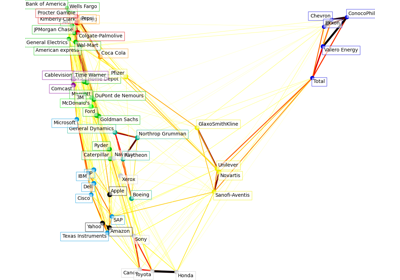sklearn.cluster.affinity_propagation¶
-
sklearn.cluster.affinity_propagation(S, *, preference=None, convergence_iter=15, max_iter=200, damping=0.5, copy=True, verbose=False, return_n_iter=False, random_state='warn')[source]¶ Perform Affinity Propagation Clustering of data.
Read more in the User Guide.
- Parameters
- Sarray-like of shape (n_samples, n_samples)
Matrix of similarities between points.
- preferencearray-like of shape (n_samples,) or float, default=None
Preferences for each point - points with larger values of preferences are more likely to be chosen as exemplars. The number of exemplars, i.e. of clusters, is influenced by the input preferences value. If the preferences are not passed as arguments, they will be set to the median of the input similarities (resulting in a moderate number of clusters). For a smaller amount of clusters, this can be set to the minimum value of the similarities.
- convergence_iterint, default=15
Number of iterations with no change in the number of estimated clusters that stops the convergence.
- max_iterint, default=200
Maximum number of iterations
- dampingfloat, default=0.5
Damping factor between 0.5 and 1.
- copybool, default=True
If copy is False, the affinity matrix is modified inplace by the algorithm, for memory efficiency.
- verbosebool, default=False
The verbosity level.
- return_n_iterbool, default=False
Whether or not to return the number of iterations.
- random_stateint, RandomState instance or None, default=0
Pseudo-random number generator to control the starting state. Use an int for reproducible results across function calls. See the Glossary.
New in version 0.23: this parameter was previously hardcoded as 0.
- Returns
- cluster_centers_indicesndarray of shape (n_clusters,)
Index of clusters centers.
- labelsndarray of shape (n_samples,)
Cluster labels for each point.
- n_iterint
Number of iterations run. Returned only if
return_n_iteris set to True.
Notes
For an example, see examples/cluster/plot_affinity_propagation.py.
When the algorithm does not converge, it returns an empty array as
cluster_center_indicesand-1as label for each training sample.When all training samples have equal similarities and equal preferences, the assignment of cluster centers and labels depends on the preference. If the preference is smaller than the similarities, a single cluster center and label
0for every sample will be returned. Otherwise, every training sample becomes its own cluster center and is assigned a unique label.References
Brendan J. Frey and Delbert Dueck, “Clustering by Passing Messages Between Data Points”, Science Feb. 2007

